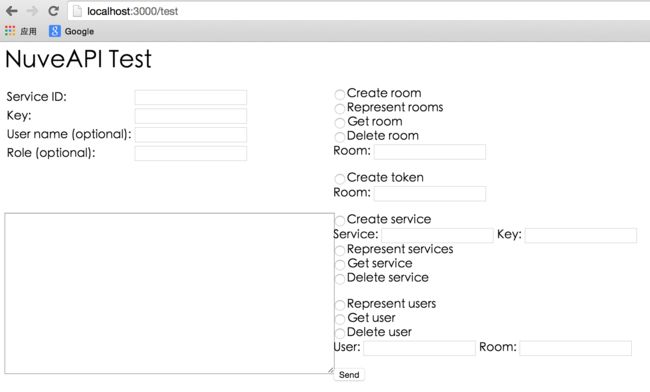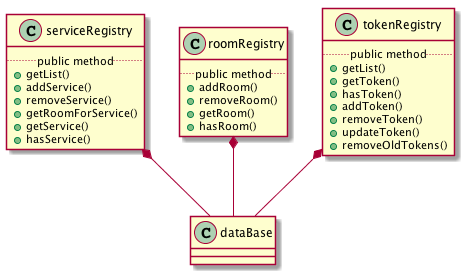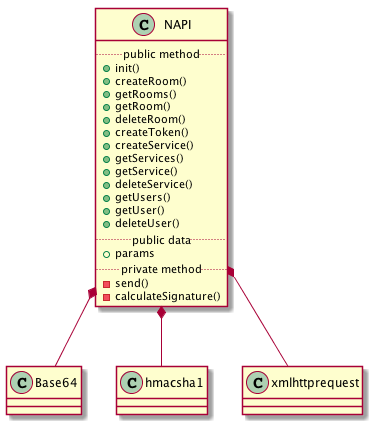Licode(二):Nuve源码分析
Licode(二):Nuve源码分析
Licode的Nove组件旨在对服务端资源进行管理(CRUD),服务端资源包括:会议房间(videoconference rooms)、加入凭证(tokens)、参与用户(User)。Nuve组件的gitHub地址:https://github.com/ging/licode/tree/master/nuve,官方对Nuve的说明如下:
Developers will manage rooms (creation and deletion) from their server apps.
Typical server apps can create a room, and request access for their users to Nuve, via a token-based authentication mechanism.
This mechanism allows these servers to create access tokens, and they will provide these tokens to their clients.
Server talks to Nuve in order to do these actions.
1、Nuve目录结构
- nuveAPI:Nuve App的实现代码
- nuveClient:NuveClient为Nuve App的客户端API
- nuveClient_python:nuveClient的python版本
- nuveClient_ruby:nuveClient的ruby版本
- initNuve.sh:Nuve App启动脚本
- installNuve.sh:NuveAPI依赖库安装、编译nuveClient脚本
- log4js_configuration.json:Nuve App Log配置文件
2、nuveAPI
2.1、总体架构
- nuve.js:通过调用resource系列类来完成CRUD操作,在进行CRUD操作之前,通过调用auth/nuveAuthenticator.js来完成权限验证,接口层
- servicesResource.js/serviceResource.js:
- roomsResource.js/roomResource.js:会议房间资源,业务逻辑层
- usersResource.js/userResource.js:参与用户资源,业务逻辑层
- tokenResource.js:加入凭证资源,业务逻辑层
- serviceRegistry.js、roomRegistry.js、tokenRegistry.js: 通过调用dataBase.js完成各种资源的CRUL操作,数据逻辑层
- dataBase.js:mongodb部署配置相关,负责维护和mongodb服务的连接,和具体业务逻辑无关
Note:
- XXXsResource.js(复数形式):负责创建、批量查询之类操作
- XXXResource.js(单数形式):负责删除、更新、单个查询之类操作
2.2、nuve.js
nuve.js为NuveAPI的入口文件,Nuve App的表现层,以webservice的方式对外提供服务,urlpath和Resource的映射关系如下:查看代码
app.post('/rooms', roomsResource.createRoom);
app.get('/rooms', roomsResource.represent);
app.get('/rooms/:room', roomResource.represent);
app.delete('/rooms/:room', roomResource.deleteRoom);
app.post('/rooms/:room/tokens', tokensResource.create);
app.post('/services', servicesResource.create);
app.get('/services', servicesResource.represent);
app.get('/services/:service', serviceResource.represent);
app.delete('/services/:service', serviceResource.deleteService);
app.get('/rooms/:room/users', usersResource.getList);
app.get('/rooms/:room/users/:user', userResource.getUser);
app.delete('/rooms/:room/users/:user', userResource.deleteUser);
每次请求会先执行权限验证逻辑:查看代码
app.get('*', nuveAuthenticator.authenticate);
app.post('*', nuveAuthenticator.authenticate);
app.delete('*', nuveAuthenticator.authenticate);
nuveAuthenticator.authenticate的执行结果为:
This function has the logic needed for authenticate a nuve request. If the authentication success exports the service and the user and role (if needed). Else send back a response with an authentication request to the client.
nuve.js还提供了一个测试页面,在vagrant虚拟机中启动Nuve App后(Note:如何在vagrant中启动Nuve App,参见Licode(一):入门的《mac X环境下,搭建licode测试环境》部分),在chrome浏览器地址栏里输入http://localhost:3000/test,可见一个如下界面:
其中,Service ID、Key配置在$ROOT/licode_config.js中:
config.nuve.superserviceID = '555f70ee0c55fbbc84e5196f'; // default value: ''
config.nuve.superserviceKey = '13518'; // default value: ''
2.3、cloudHandle.js
cloudHandle旨在调用erizoController App中的方法,从而在Nuve App中实现对erizoController App状态的干预,cloudHandle通过RabbitMQ来实现的RPC(Remote Procedure Call),rpc.js实现RPC的方式和amqper.js一样,可以认为amqper.js为rpc.js的升级版本,先看下cloudHandle的类图(Class Diagram):
rpc.js的原理
Nuve App和erizoController App通过RabbitMQ维护了两队列,队列1用来传递调用消息,Nuve App发布调用消息后,会将callback保存至本地字典表中;erizoController App从队列1获取调用消息,完成方法调用之后,push调用结果消息至队列2中;Nuve App从队列2获取调用结果消息,从字典表中找到对应的callback并从字典表中删除,执行callback(调用消息),至此一次RPC调用完成。从上面可以看出,这是个异步的过程,不会对Nuve App和erizoController App其他业务逻辑有任何影响。
2.4、nuveAuthenticator.js
nuveAuthenticator.js为Nuve App提供了权限验证功能,其实现原理:
NuveClient在发送http请求时构建Authorization头部,在Authorization中包含mauth_signature字段,mauth_signature值的计算方式如下:查看代码
calculateSignature = function (toSign, key) {
var hash, hex, signed;
hash = CryptoJS.HmacSHA1(toSign, key);
hex = hash.toString(CryptoJS.enc.Hex);
signed = N.Base64.encodeBase64(hex);
return signed;
};
Key为NuveClient事先和Nuve App约好的密钥,而toSign的值计算方式如下:查看代码
var signed;
timestamp = new Date().getTime();
cnounce = Math.floor(Math.random() * 99999);
toSign = timestamp + ',' + cnounce;
toSign += ',' + username + ',' + role;
Nuve App收到NuveClient发送过来的请求后,从HttpHeader中提取Authorization,从Authorization中提取signed(calculateSignature的结果)、mauth_timestamp、mauth_cnonce、mauth_username、mauth_role,按照和NuveClient相同的方式计算出calculatedSignature,如果calculatedSignature === signed,验证通过,否则验证失败:查看代码
var checkSignature = function (params, key) {
"use strict";
if (params.signature_method !== 'HMAC_SHA1') {
return false;
}
var calculatedSignature = mauthParser.calculateClientSignature(params, key);
if (calculatedSignature !== params.signature) {
return false;
} else {
return true;
}
};
2.5、xxxResource.js
servicesResource.js/serviceResource.js类图(Class Diagram)如下:
roomsResource.js/roomResource.js类图(Class Diagram)如下:
usersResource.js/userResource.js类图(Class Diagram)如下:
tokenResource.js类图(Class Diagram)如下:
2.6、xxxRegistry.js
xxxRegistry.js的功能是实现room、service、token的CURL,逻辑简单,所以这里不再一一赘述,直接参阅代码即可,这里仅给出类图(Class Diagram):
room、service、token资源信息落地至mongodb中,mongodb配置在$ROOT/licode_config.js中:
config.nuve.dataBaseURL = "localhost/nuvedb"; // default value: 'localhost/nuvedb'
Data base collections and its fields are:
room {name: '', [p2p: bool], [data: {}], _id: ObjectId}
service {name: '', key: '', rooms: Array[room], testRoom: room, testToken: token, _id: ObjectId}
token {host: '', userName: '', room: '', role: '', service: '', creationDate: Date(), [use: int], [p2p: bool], _id: ObjectId}
3、NuveClient
NuveClient本身为js实现,其为Video App提供调用接口,主要功能是发送HttpRequest请求至服务端,N.API.js类图(Class Diagram)如下:
4、写在最后
nuveClient_python和nuveClient_ruby功能上和nuveClient一样,不同语言版本而已,所以不再赘述
参考资料:
- licode官网文档:http://lynckia.com/licode/architecture.html
- AMQP协议:http://langyu.iteye.com/blog/759663








